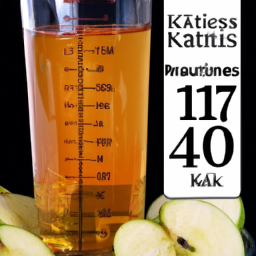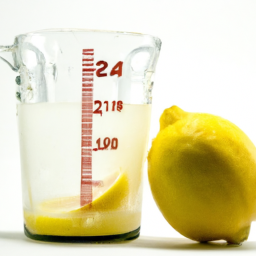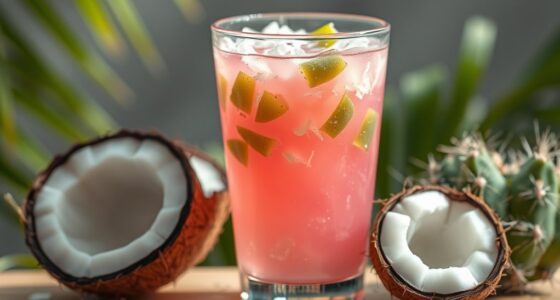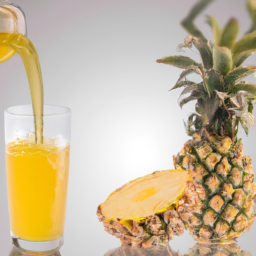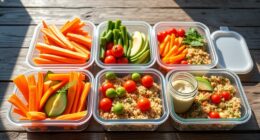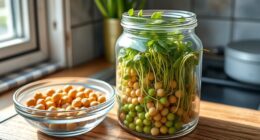The other day, as I was getting ready to enjoy a refreshing glass of orange juice, I found myself wondering – how much juice does one orange yield?
This question may seem trivial, but as someone who loves juicing, it’s important to understand the factors that impact juice yield, how to choose the best oranges for juicing, and how to maximize juice yield.
So, I decided to do some research and share my findings with you. It turns out that understanding how much juice one orange yields is not as straightforward as you might think.
There are several factors that can impact juice yield, such as the type of orange, its ripeness, and the juicing method used. In this article, I will explore these factors in more detail and provide tips for getting the most juice out of your oranges.
So, let’s dive in and discover just how much juice one orange can provide.
Key Takeaways
- The amount of juice one orange can yield depends on various factors, such as the type of orange, its ripeness, and the juicing method used.
- Ripe and heavy oranges are preferred for juicing as they yield more juice. Smooth-skinned and firm oranges are also easier to peel and preferred for juicing.
- Cutting oranges in half and using a citrus juicer is the most efficient method for juicing. Rolling oranges before juicing, squeezing leftover pulp, and using a hard surface to break up pulp can help increase juice yield.
- Orange juice can provide numerous health benefits, including antioxidants that protect cells from damage and promote overall health. Incorporating orange juice into your diet is a simple and delicious way to increase your intake of antioxidants and support your overall health.
Factors Affecting Juice Yield
You’ll be surprised at how much juice you can get from one orange depending on factors such as its ripeness and the amount of pressure you apply when squeezing it. Juice extraction techniques also play a significant role in determining the amount of juice you can extract from an orange. For instance, using a citrus juicer will help you extract more juice than squeezing the fruit manually.
The impact of orange maturity on juice yield cannot be overlooked. Ripe oranges yield more juice than unripe ones. Therefore, you should always select ripe oranges if you want to get the most juice.
With this understanding, let’s explore how to choose the best oranges for juicing.
How to Choose the Best Oranges for Juicing
When it comes to choosing the best oranges for juicing, there are a few key points to keep in mind. Firstly, I always look for oranges that feel heavy for their size, as this indicates that they’re likely to be juicy.
Secondly, I opt for oranges with smooth skin, as this suggests that they’re ripe and not damaged.
Finally, I make sure to choose oranges that are firm to the touch, as this indicates that they’re fresh and full of juice.
By following these guidelines, I can ensure that I get the most juice possible out of my oranges when juicing.
Look for heavy oranges
Interestingly enough, the weight of an orange can greatly impact the amount of juice you can extract from it. When choosing oranges for juicing, it’s important to look for heavy ones. The weight of an orange is a good indicator of how much juice it will yield. Heavier oranges tend to be juicier and have thicker skins, which makes them easier to juice.
To give you an idea of how much juice you can extract from an orange, take a look at the table below. The table shows the average weight and juice yield for different types of oranges. As you can see, the heavier the orange, the more juice it yields. So, when you’re at the grocery store trying to choose the best oranges for juicing, be sure to pick up a few heavy ones.
| Type of Orange | Average Weight (grams) | Juice Yield (milliliters) |
|---|---|---|
| Navel | 140 | 100 |
| Valencia | 160 | 120 |
| Blood | 180 | 140 |
| Cara Cara | 200 | 160 |
Choosing juicy oranges with thick skins is just one step in getting the most out of your oranges. Another important factor is choosing oranges with smooth skin. Smooth-skinned oranges are easier to peel, which means you’ll be able to extract more juice. So, the next time you’re at the grocery store, be sure to look for oranges that are both heavy and have smooth skin.
Choose oranges with smooth skin
To get the most out of your oranges, it’s important to pick ones with smooth skin that are easy to peel. The texture of an orange’s skin can indicate a lot about its quality and freshness. Smooth skin is a sign that the orange is ripe and has been well taken care of. Bumpy or rough skin, on the other hand, can indicate that the orange is overripe or has been damaged during transportation.
The importance of smooth skin goes beyond just aesthetics. It also affects the juicing process. Oranges with smooth skin are easier to peel, which means less of the juicy flesh is lost in the process. This is important if you’re trying to get as much juice as possible out of your oranges.
When juicing, it’s also helpful to roll the orange on a hard surface before cutting it open. This can help break up the pulp and release more juice. With these juicing techniques, you’ll be able to get the most out of your smooth-skinned oranges.
When choosing oranges that are firm, it’s important to keep in mind that this can also impact the juicing process.
Choose oranges that are firm
If you want to enjoy a fresh and juicy orange, look for ones that feel firm when you squeeze them gently. This is an important step in choosing ripe oranges and avoiding overripe ones.
When an orange is too soft, it may be overripe and not as juicy. On the other hand, if the orange is too hard, it may not be fully ripe and lack sweetness.
To get the most juice out of your oranges, it’s important to use the right juicing technique. Here are three tips to maximize your yield:
1) Roll the orange on a hard surface before juicing to break down the flesh and release more juice.
2) Cut the orange in half and use a juicer or press to extract the juice.
3) Squeeze the leftover pulp to extract any remaining juice.
With these techniques, you can enjoy a glass of fresh orange juice that is both delicious and nutritious.
When it comes to preparing oranges for juicing, there are a few simple steps you can take to make the process easier.
How to Prepare Oranges for Juicing
First, I always wash my oranges before juicing them to make sure they’re clean and free of any dirt or pesticides.
Then, I cut the oranges in half using a sharp knife to make it easier to squeeze out the juice.
Finally, I roll the oranges on a hard surface to help release even more juice from the fruit.
These simple steps ensure that I get the most juice possible from my oranges and that it’s as fresh and delicious as possible.
Wash the oranges
After rinsing the oranges under cool water, gently scrub the skin with a soft-bristled brush to remove any dirt or residue.
Next, soak the oranges in a bowl of water for about 5 minutes. This will help loosen any remaining dirt or debris from the skin. Soaking also helps to soften the fruit, making it easier to extract juice.
Using a citrus juicer is important when preparing oranges for juicing. Not only does it ensure that you get the maximum amount of juice from each fruit, but it also eliminates the need for hand squeezing, which can be time-consuming and messy.
Once the oranges have been washed and soaked, simply cut them in half and place them in the juicer. The juicer will do the rest, separating the juice from the pulp and seeds.
Cut the oranges in half
Once you’ve washed and soaked them, simply cut the oranges in half like slicing a hot knife through butter, and place them in the juicer. Juice extraction is made easy with the proper equipment options. There are two types of juicers to choose from: centrifugal and masticating. Centrifugal juicers are fast and efficient, but they tend to create more foam and may not extract as much juice from the fruit. Masticating juicers, on the other hand, are slower but tend to extract more juice and preserve more nutrients.
When using a juicer, it’s important to note that the orange should be cut in half with the skin still on. This allows the juice to be extracted from the pulp and skin. The table below provides a breakdown of the different equipment options available for juicing oranges.
| Equipment | Pros | Cons |
|---|---|---|
| Hand held citrus juicer | Easy to use | May not extract as much juice |
| Electric citrus juicer | Quick and efficient | May create more foam |
| Centrifugal juicer | Fast and efficient | May not extract as much juice |
| Masticating juicer | Extracts more juice and preserves nutrients | Slower process |
Rolling the oranges before juicing can help release even more juice from the fruit.
Roll the oranges to release more juice
To enhance the juicing process, it’s advisable to roll the oranges before slicing them in half, as this can help to extract the maximum amount of juice from the fruit. Rolling the oranges helps to break down the cell walls inside the fruit, allowing the juice to flow more freely.
Here are some benefits of rolling oranges and the best tools for juicing oranges:
-
Benefits of rolling oranges:
-
Releases more juice: Rolling the oranges helps to break down the cell walls inside the fruit and release more juice.
-
Saves time: Rolling the oranges before juicing them can save time because you’ll be able to extract more juice from each fruit.
-
Prevents waste: By squeezing out more juice from each orange, you can reduce the amount of waste produced.
-
Best tools for juicing oranges:
-
Handheld citrus juicer: This tool is great for juicing oranges because it allows you to extract the maximum amount of juice from each fruit.
-
Manual juicer: A manual juicer is a good option if you’re juicing a large quantity of oranges because it can handle the volume.
-
Electric juicer: An electric juicer is the best option if you’re juicing a lot of oranges because it’s fast and efficient.
When it comes to juicing oranges, rolling them beforehand can make a big difference in the amount of juice you’re able to extract. However, there are many other popular juicing methods to explore, each with their own benefits and drawbacks.
Popular Juicing Methods
Juicing is a popular way to consume fruits and vegetables, and according to a survey, 43% of Americans prefer using a juicer to make their juice. There are several popular juicing methods that people use to extract juice from fruits and vegetables. Some of the most common juicing equipment includes centrifugal juicers, masticating juicers, and citrus juicers.
Centrifugal juicers are the most popular type of juicer and are great for juicing hard fruits and vegetables. They work by using a spinning blade to shred the produce into small pieces, and then a mesh filter separates the juice from the pulp. Masticating juicers, on the other hand, use a slow and steady process to extract juice. They work by grinding the produce into a pulp and then squeezing the juice out. Citrus juicers are designed specifically for juicing oranges, lemons, limes, and grapefruits. They work by using a reamer to extract the juice from the citrus fruit. Juicing can also be a great way to aid in weight loss, as it can help increase your intake of fruits and vegetables, which are low in calories and high in nutrients.
If you’re wondering how much juice you can expect from one orange, it depends on the size and type of orange. On average, one medium-sized orange can yield about 1/4 to 1/3 cup of juice. However, some types of oranges may yield more or less juice than others. Now that we’ve covered popular juicing methods, let’s dive into how to get the most juice out of an orange.
How Much Juice Can You Expect from One Orange?
If you’re looking to add a burst of citrus flavor to your morning routine, you’ll be happy to know that a medium-sized orange can yield a quarter to a third cup of freshly squeezed juice. However, the amount of juice you get from an orange can vary depending on different factors such as juice extraction techniques, acidity levels in oranges and juice yield.
When it comes to juice extraction techniques, using a juicer can yield more juice than squeezing by hand. Also, the level of acidity in an orange can affect the amount of juice yield. Oranges with higher acidity levels tend to yield more juice than those with lower acidity levels.
While the amount of juice you get from one orange may not seem like much, it can add up quickly if you’re juicing multiple oranges.
In the next section, we’ll discuss some tips for maximizing juice yield.
Tips for Maximizing Juice Yield
You’ll be amazed at how much more juice you can get out of your oranges by gently rolling them on your countertop before juicing them. This simple technique helps to break down the individual juice sacs and release more juice.
Another tip for maximizing juice yield is to use a citrus press instead of just squeezing the oranges by hand. A citrus press can extract more juice and is also more efficient, saving you time and effort. When using a citrus press, it’s important to cut the oranges in half and place them cut-side-down in the press. Then, simply apply pressure to the handle and let the press do the work for you.
With these tips, you can extract the most juice possible from your oranges and enjoy a refreshing glass of orange juice. As for storing orange juice, there are a few steps you can take to keep it fresh.
Storing Orange Juice
Now that we’ve covered some tips to maximize the juice yield of an orange, let’s talk about the best way to store that freshly squeezed juice.
Storing orange juice properly is important to maintain its flavor and prevent oxidation. To keep orange juice fresh, it’s best to store it in an airtight container in the refrigerator. This will slow down the oxidation process, which can cause the juice to turn sour.
It’s also important to keep the juice away from light, as UV rays can break down the vitamins in the juice. To further prevent oxidation, you can add a small amount of lemon juice to the orange juice. The citric acid in lemon juice can inhibit the oxidation process and keep the juice fresher for longer.
Did you know? Orange juice can be stored in the freezer for up to six months! Just be sure to use a freezer-safe container and leave some room for expansion.
Fun Fact: Glass bottles are the best containers for storing orange juice, as they do not release any chemicals that can affect the flavor of the juice.
Pro Tip: If you want to keep orange juice fresh for a few extra days, try adding a pinch of salt to the juice before storing it in the fridge. The salt will help to preserve the juice and prevent it from spoiling too quickly.
Now that we know how to properly store our freshly squeezed orange juice, let’s move on to the next step: using it in recipes.
Using Orange Juice in Recipes
I love using orange juice in my cooking and baking. It adds a bright and refreshing flavor to dishes. One of my favorite ways to use orange juice is in drinks, such as smoothies and cocktails.
Additionally, it can be used in sauces and marinades to add a tangy kick to meat or vegetables. It can also be used in baked goods such as muffins and cakes for a burst of citrus flavor.
Drinks
Let’s quench our thirst with a refreshing glass of orange juice – do you know how much juice we can get from just one orange? Well, it actually depends on the size and ripeness of the orange. On average, a medium-sized orange can yield around 1/3 to 1/2 cup of juice. However, if you want to get the most juice out of your oranges, try using juicing techniques like rolling the orange on a hard surface to break the individual juice sacs, or microwaving the orange for a few seconds to soften it up before squeezing.
If you’re looking for alternative citrus fruits to try, there are plenty of options that can also make delicious drinks. Grapefruits, lemons, and limes are all great for making juices and can add a unique twist to your usual orange juice. Keep in mind that these citrus fruits may yield different amounts of juice compared to oranges, so adjust accordingly.
Now, let’s move on to the next section about sauces and marinades. Did you know that orange juice can also be a great ingredient for adding flavor to your dishes?
Sauces and marinades
You can add a burst of tangy sweetness to your dishes by incorporating the zesty flavor of oranges into your sauces and marinades. Oranges are a versatile fruit that can be used in both savory pairings and sweet applications.
Here are some ways to incorporate oranges into your cooking:
- Use orange juice as a base for a marinade for chicken or fish
- Add orange zest to a vinaigrette for a bright, citrusy flavor
- Mix orange juice with honey and soy sauce for a sweet and savory glaze for roasted vegetables or meats
Incorporating oranges into your sauces and marinades can take your cooking to the next level. But oranges can also be used in baked goods for a sweet and tangy twist.
Baked goods
I hope you enjoyed learning about sauces and marinades in the previous section. Now, let’s move on to baked goods and explore the creative uses and pairing suggestions for orange juice.
Orange juice is a versatile ingredient that can be used in a variety of baked goods, from cakes and muffins to breads and cookies. Its tangy and sweet flavor adds a citrusy twist to traditional recipes. You can swap water or milk with orange juice in your baked goods recipe to give it a unique flavor.
If you’re feeling adventurous, try adding orange juice to your frosting or glaze for an extra burst of flavor. For pairing suggestions, orange juice goes well with other citrus flavors like lemon or lime. You can also pair it with ingredients like nuts, chocolate, and spices like cinnamon or ginger for a delicious flavor combination.
As we move on to the next section, let’s not forget about the health benefits of orange juice.
Health Benefits of Orange Juice
I love drinking orange juice, not only because of its refreshing taste, but also because of its numerous health benefits.
One of the most well-known benefits of orange juice is its high vitamin C content, which helps boost immunity and heal wounds.
Additionally, orange juice contains antioxidants that protect cells from damage and promote overall health.
Its hydrating properties can help keep you feeling refreshed and energized throughout the day.
Vitamin C content
The vitamin C content in the juice of one orange is significant. Benefits of vitamin C include a strengthened immune system, improved skin health, and reduced risk of chronic diseases. The recommended daily intake of vitamin C for adults is 75-90mg.
One medium-sized orange contains around 70mg of vitamin C, which means that drinking a glass of orange juice can help you meet your daily vitamin C needs. In comparison to other fruits, oranges are one of the best sources of vitamin C. For instance, a medium-sized orange contains more vitamin C than a cup of strawberries or a kiwi.
However, oranges are not the only fruit that contains vitamin C. Other fruits like guavas, papayas, and pineapples are also excellent sources of this vitamin. Moving on to the next section, antioxidants are another important component of orange juice that contribute to its health benefits.
Antioxidants
You’ll be pleased to know that antioxidants are present in orange juice, which can lower your risk of chronic diseases like cancer and heart disease. Antioxidants are compounds that help protect your cells from damage caused by free radicals. Free radicals are unstable molecules that can build up in your body and cause damage to cells, DNA, and proteins. The benefits of antioxidants include reducing inflammation, improving immune function, and protecting against chronic diseases.
There are many sources of antioxidants, including fruits, vegetables, nuts, and seeds. However, orange juice is a particularly good source of antioxidants because it contains high levels of vitamin C, flavonoids, and carotenoids. Vitamin C is a powerful antioxidant that can help boost your immune system and protect against infections. Flavonoids and carotenoids are other types of antioxidants that can help protect your cells from damage. Incorporating orange juice into your diet is a simple and delicious way to increase your intake of antioxidants and support your overall health.
Drinking enough fluids is essential for staying hydrated and maintaining optimal health.
Hydration
Staying hydrated is crucial for feeling energized and refreshed throughout the day. Water makes up a considerable portion of our body, and it plays a vital role in maintaining body temperature, transporting nutrients, and detoxifying wastes.
Drinking enough water is essential for the optimal functioning of our body, and it comes with numerous benefits. One of the most crucial benefits of hydration is that it helps in maintaining the balance of fluids in our body.
Dehydration can lead to various health issues, such as headaches, fatigue, and even kidney problems. Drinking enough water throughout the day can help prevent these issues and keep us feeling our best. Additionally, staying hydrated can improve our skin’s appearance, aid in digestion, and boost our immune system.
Therefore, it’s crucial to recognize the importance of staying hydrated and make sure we drink enough water to keep our bodies functioning at their best.
Frequently Asked Questions
How long does it take to juice one orange?
After investigating, I’ve found that juicing one orange can take anywhere from 30 seconds to 2 minutes depending on juicing techniques and orange juice extraction methods used. It’s important to select a juicy orange to maximize yield.
Can you juice an orange with the peel still on?
Juicing an orange with the peel on is possible, but it may produce a bitter taste and a gritty texture. However, leaving the peel on can provide additional nutritional benefits, such as fiber and vitamin C.
What is the best time of day to juice an orange for maximum juice yield?
Juicing oranges at any time of day can yield maximum juice, but using different techniques can affect the amount extracted. Freshly squeezed orange juice has numerous benefits, including high vitamin C content and improved digestion.
Are there any types of oranges that should not be used for juicing?
When it comes to juicing oranges, it is best to use varieties that are juicy and have thin skin. Navel and Valencia oranges are great options. Alternatively, you can also try juicing other fruits like grapefruits or lemons.
Can you freeze freshly squeezed orange juice for later use?
Yes, freshly squeezed orange juice can be frozen for later use. However, it may lose some of its nutritional value. It’s best to consume the juice as soon as possible to reap the full benefits.
Conclusion
Overall, juicing oranges is a great way to enjoy a refreshing and healthy drink. While the amount of juice you can expect from one orange may vary based on factors such as the variety of orange and the juicing method used, typically one orange will yield around 1/3 to 1/2 cup of juice.
To maximize your juice yield, choose ripe, juicy oranges and use a juicer or citrus press. Some may argue that juicing removes important fiber from oranges and therefore it’s better to eat the whole fruit. While it’s true that juicing does remove some of the fiber, it also provides a concentrated source of vitamins, minerals, and antioxidants that can be easily absorbed by the body.
Plus, using a juicer or citrus press allows you to extract more juice from the orange than you might be able to by hand, making it a convenient and efficient way to get your daily dose of vitamin C. So, go ahead and enjoy a glass of fresh-squeezed orange juice today!
Ilana has been a vegan for over 10 years. She originally made the switch for health reasons, but soon found herself becoming more and more passionate about the ethical and environmental implications of a vegan lifestyle. Ilana is the author of The Graceful Kitchen, a blog all about veganism. She loves to cook up delicious and nutritious vegan meals, and share her recipes with others who are interested in leading a cruelty-free life. Ilana is also a strong advocate for using whole foods as the foundation of a healthy diet, and believes that going vegan is one of the best ways to achieve this.



